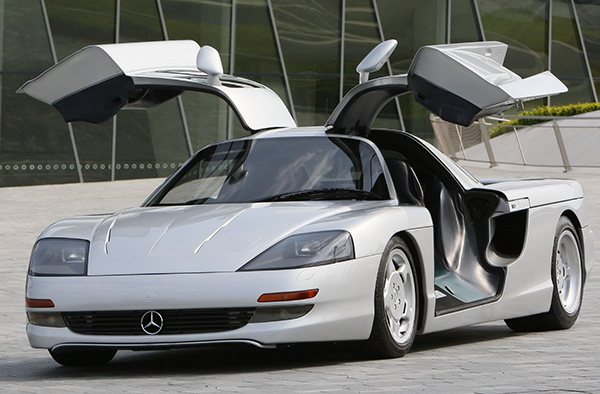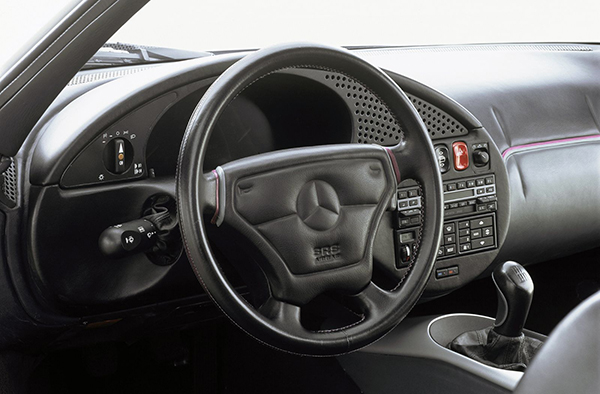A test vehicle and supercar in one. In 1991, the innovative Mercedes-Benz C 112 served as a technological prototype while reaching a top speed of over 300 km/h.
Mercedes-Benz C 112 | 60 seconds
During the 1980s and 1990s, European carmakers introduced some of the most iconic supercars ever built, with examples ranging from the Ferrari F40 to the McLaren F1.
For Mercedes-Benz, this illustrious period was highlighted by thoroughbred race cars adapted for the road like the CLK GTR Straßenversion (Street version). Fitted with a massive, 622-hp (631 ps) V12, it was basically the two-time FIA GT Championship-winning car in road-legal guise.
Seven years earlier, Mercedes developed another mid-engine supercar that, in many ways, was just as exciting as the GTR. Although it never made it into production and few remember it today, the C112 was mind-blowing back then, and it’s still a sophisticated, high-tech machine today.
A different kind of supercar
As I mentioned before, supercars were springing up like mushrooms after the rain during that period. But, instead of creating a typical mid-engine, high-performance vehicle, Mercedes decided to develop the world’s safest, most well-mannered supercar.
This philosophy did not include compromises when it came to performance or design but rather added ingredients like sophisticated safety systems, and futuristic technologies, as well as S-Class levels of comfort and luxury to the traditional supercar recipe.
A production run was seriously considered, so the design and engineering teams worked hard to create a vehicle that was both spectacular and also marketable anywhere in the world, including countries with draconian emissions or safety regulations.

From an ambitious idea to a fully-functional prototype
Development of the C112’s underpinnings was handed out to a team led by Karl Hoehl which included twenty of the German company’s best engineers, while the design work was the responsibility of the legendary Bruno Sacco and the bright minds at the Mercedes-Benz Advanced Design studio. After the initial sketches were drawn, the teams created several clay models which were extensively wind tunnel-tested, then the actual car was built.
The chassis was heavily inspired by that of the Sauber-built Group C prototype race cars, the Le Mans-winning C9, or its successor, the Mercedes-Benz C11. It was constructed around an aluminum-alloy monocoque and only weighed 130 lbs. (59 kg). Additionally, it was reinforced with a tubular steel sub-frame that acted like a built-in roll cage, increasing safety and also improving overall chassis rigidity.
The body, which also drew inspiration from the Group C prototypes was put together by Italian coachbuilder Carrozzeria Coggiola using Kevlar and aluminum panels. It was designed to be as aerodynamically efficient as possible, achieving a drag coefficient of 0.30 – a figure that’s still impressive today. To this end, designers opted against using pop-up headlights, which were very popular back then, and instead created fixed units like those used on the aforementioned race cars.
The structure also featured the carmaker’s trademark gullwing doors which opened and closed with the push of a button thanks to a hydraulic system. Moreover, the body and chassis were designed to gradually deform in case of a crash.
Pioneering active aerodynamics
Today, many high-performance sports cars use active components that improve aerodynamics at high speeds. The most widespread example is the active rear wing which, in some cases also aids braking.
The C111 was one of the first supercars to feature such a wing that could adjust its angle automatically with the help of a complex electrical system. According to the manufacturer, it improved both high-speed aerodynamics and braking efficiency in case of an emergency.
Even more impressive, especially for an early-1990s car, the innovative prototype also featured an active front spoiler. Mounted under the front bumper and fabricated out of Kevlar, it worked in tandem with the rear wing to provide the optimal amount of downforce.

A testbed for innovative tech
Apart from active aerodynamics, the C111 was brimming with high-tech features that would later make their way into many production models.
To improve safety, Mercedes engineers integrated the most advanced version of their ground-breaking ABS featuring a new control unit with superior computing power that automatically adjusted the brakes to prevent the wheels from locking.
The ABS worked with a novel, ASR (Anti-Schlupf Regelung) unit that prevented wheelspin by automatically applying the brakes and reducing the throttle opening. Moreover, the C112’s handling was dramatically improved using a rear-wheel steering system dubbed Cybernetic. This system also shared the novel control unit with the ABS and ASR, adjusting the toe angle of the rear wheels using hydraulic cylinders integrated into the rear suspension.
The fourth innovative system was called Automatic Body Control (ABC) which could electronically adjust suspension damping and spring rates. It could do so automatically, or according to the setting chosen by the driver via a switch found in the cabin.
Showcasing the carmaker’s legendary M120 V12
Behind the luxurious pair of seats, engineers placed the brand’s latest flagship engine, the 6.0-litre M120. A naturally aspirated, all-aluminum V12, it was one of the most advanced engines of its era. But, since it was primarily designed for the S-Class, its output was by no means mind-blowing. Mated to a bespoke six-speed transaxle, it made a healthy 402 hp (408 ps) and 428 lb-ft (580 Nm) of torque which was good for the early-1990s, but not really great for a car that weighed 3,459 lbs. (1,569 kg).
Mercedes never performed any official speed tests, but the company stated that, in theory, the C112 could reach 63 mph (100 kph) from a standstill in 4.9 seconds and reach a top speed of 192 mph (309 kph).
That being said, if the car went into production and an M120 version was specifically developed for it, performance would have unquestionably improved. The iconic V12’s architecture had the potential to deliver massive amounts of power, as shown by the larger displacement, 600 hp + units, that were developed for the Pagani Zonda.
Unfortunately, Mercedes-Benz executives decided against a limited-production run of the impressive C112, despite receiving more than 700 orders shortly after unveiling the car at the 1991 Frankfurt Motor Show.
Those who desperately wanted a Mercedes supercar and had the means to buy one got one seven years later when the GTR Straßenversion was unleashed. After that, the C112 was slowly but surely forgotten by fans of the brand, but despite that, it remains one of the most fascinating high-performance vehicles of the 1990s.